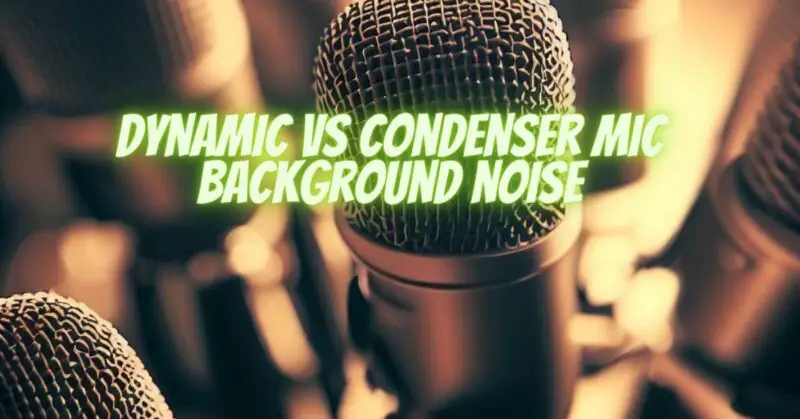When it comes to selecting a microphone for your recording needs, understanding the characteristics and performance of different microphone types is crucial. One significant aspect to consider is the background noise performance of dynamic and condenser microphones. In this article, we will delve into the topic of background noise and compare the performance of dynamic and condenser microphones in this regard. By understanding their differences, you can make an informed decision and choose the microphone that best suits your specific recording environment and application.
Background Noise in Microphones: Background noise refers to the unwanted sounds captured by a microphone along with the desired audio source. It can be generated by various sources, such as ambient room noise, electrical interference, or self-noise produced by the microphone itself. Minimizing background noise is crucial for achieving clean and high-quality recordings.
Dynamic Microphones and Background Noise: Dynamic microphones are known for their robust construction and ability to handle high sound pressure levels. In terms of background noise performance, dynamic microphones generally exhibit low self-noise due to their passive design. They do not require external power (phantom power) and rely on electromagnetic induction to generate an electrical signal. As a result, dynamic microphones are often preferred in live sound applications and environments where background noise is a concern.
Condenser Microphones and Background Noise: Condenser microphones are renowned for their exceptional sensitivity and extended frequency response. However, they tend to be more sensitive to background noise compared to dynamic microphones. This is partly due to the active circuitry and the requirement of phantom power. The internal electronics of condenser microphones introduce a certain level of self-noise, which can become more noticeable in quiet recording settings or when recording low-level audio sources. However, it’s important to note that advancements in microphone technology have significantly reduced self-noise in modern condenser microphones.
Mitigating Background Noise: Regardless of the microphone type, there are several techniques you can employ to minimize background noise during recordings:
- Proper Mic Placement: Positioning the microphone close to the desired sound source and away from noise-generating elements can help reduce unwanted background noise.
- Acoustic Treatment: Implementing acoustic treatment in your recording space, such as using sound-absorbing panels or diffusers, can help minimize reverberation and external noise.
- Noise Gates: Noise gates are audio processors that allow audio to pass through when the signal exceeds a certain threshold, effectively reducing background noise during silent or low-level passages.
- Post-Processing: Utilizing digital audio editing software, you can employ noise reduction plugins or techniques to further reduce background noise during post-production.
Conclusion:
When it comes to background noise performance, dynamic microphones generally exhibit lower self-noise compared to condenser microphones. However, advancements in technology have significantly improved the self-noise characteristics of condenser microphones. The choice between dynamic and condenser microphones should be based on your specific recording needs, environment, and the level of background noise present. By employing proper recording techniques and utilizing noise mitigation strategies, you can achieve clean and professional-sounding recordings regardless of the microphone type you choose.


